Townsend Courtney M.Jr., Evers B. Mark. Atlas of General Surgical Techniques: Expert Consult
Подождите немного. Документ загружается.

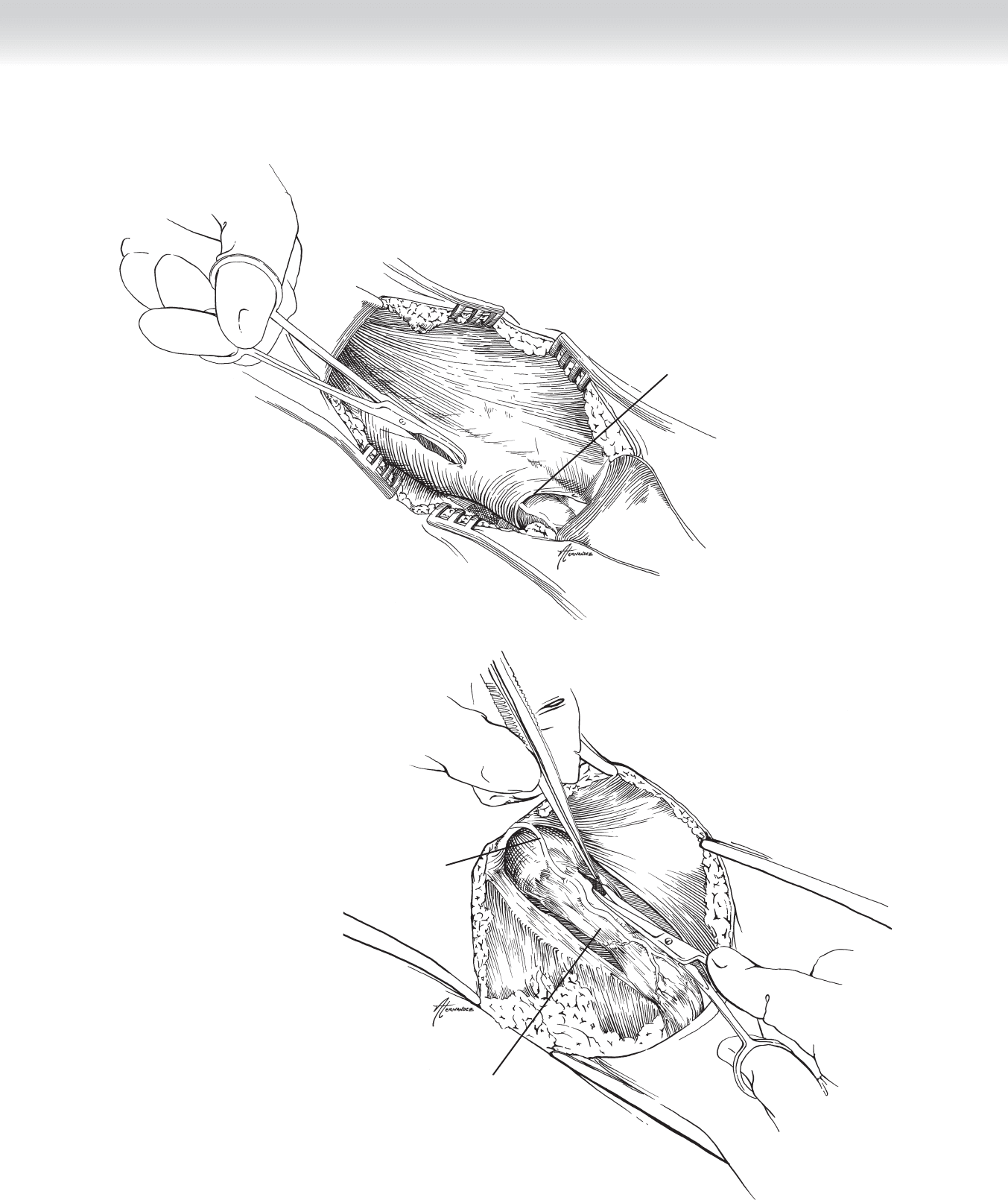
CHAPTER 71 • Hernia Repair: General Principles—Tension-Free versus Tension 789
External inguinal ring
FIGURE 71 –6
Ilioinguinal nerve
Cremaster muscle
FIGURE 71 –7

790 Section XI • Hernias
◆ Superiorly, inferiorly, and posteriorly, the cremasteric fi bers should be separated circumfer-
entially from the structures of the spermatic cord. A Penrose drain can then be placed
around the spermatic cord for traction as shown in Figure 71-8.
◆ In the case of an indirect hernia, this process will expose the hernia sac lying on the anterior
superior part of the cord, as illustrated in Figure 71-8.
◆ The indirect hernia sac should then be separated carefully from the spermatic cord well up
into the internal ring. Care should be taken to take down any soft tissue connections between
the sac and the borders of the internal ring so that the sac can be restored to the preperitoneal
space. Figure 71-8 illustrates the view on completion of this process. As shown, the inferior
epigastric vessels can be seen medial to the sac and spermatic cord.
◆ Figure 71-9 shows the appearance of a direct hernia. Once the spermatic cord is retracted
with a Penrose drain, the direct sac can be easily dissected free of the cord and cremasteric
fi bers.
3. CLOSING
◆ Various options for repair of the hernia defect will be described in the following chapters.
◆ Once the repair is completed, the aponeurosis of the external oblique is reapproximated
with a running absorbable suture, in the process recreating the external inguinal ring.
◆ Scarpa’s fascia and superfi cial subcutaneous tissues are closed with interrupted absorbable
suture.
◆ The skin is closed with running, subcuticular, absorbable suture reinforced with Steri-Strips.
STEP 4: POSTOPERATIVE CARE
◆ Most of these repairs are outpatient procedures, and patients can be discharged with a
prescription for a mild analgesic agent.
◆ Activity instructions will vary with the type of repair and the opinion of the individual surgeon.
In most cases, I advise patients to advance their level of activity as tolerated.
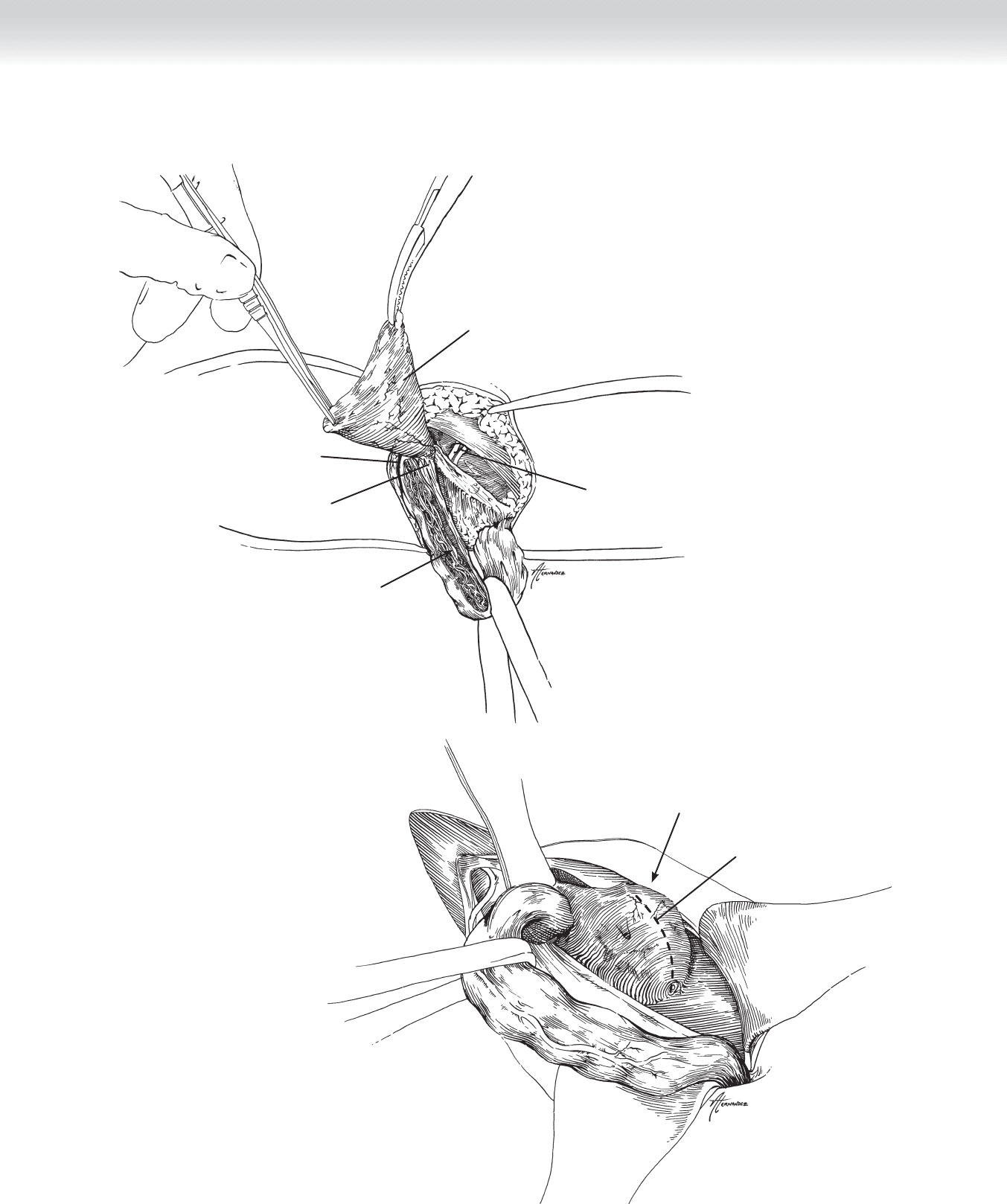
CHAPTER 71 • Hernia Repair: General Principles—Tension-Free versus Tension 791
Internal inguinal ring
Indirect hernia sac
Soft tissue connections
Inferior epigastric vessels
Spermatic cord contents:
Ductus deferens
Testicular artery
Pampiniform plexus
Lymph vessels
FIGURE 71 –8
Direct hernia
Incision line for
transversalis fascia
FIGURE 71 –9

792 Section XI • Hernias
STEP 5: PEARLS AND PITFALLS
◆ Although long-known as “intern cases,” a careful review of the outcome literature on hernia
repair shows conclusively that experience and knowledge produce better results.
◆ Superfi cial postoperative hematomas generally arise from a failure to secure the superfi cial
epigastric veins that are encountered in exposing the external oblique aponeurosis. Although
not always necessary, the safest course is to divide them between an appropriate suture liga-
ture, such as 3-0 silk or Vicryl.
◆ In separating the structures of the spermatic cord from the investing cremasteric fi bers, it is
helpful to remember that the ductus deferens is usually the most posterior element that
needs be mobilized and is easily identifi ed by palpation. Although the genital branch of the
genitofemoral nerve is posterior to the ductus deferens, I have not found it necessary to
mobilize the nerve to obtain necessary exposure.
◆ Sharp dissection of an internal hernia sac off the spermatic cord with good exposure by
traction and countertraction is less likely to lead to damage to the pampiniform venous
plexus than blunt dissection.
SELECTED REFERENCES
1. Zinner MJ, Schwartz SI, Ellis H: Hernias. In Maingot R, Zinner M (eds): Maingot’s Abdominal Operations,
vol 1, 10th ed. Stamford, Conn, Appleton & Lang, 1997, pp 479-580.
2. Condon RE: The anatomy of the inguinal region and its relation to groin hernias. In Nyhus LM, Condon
RE (eds): Hernia, 4th ed. Philadelphia, JB Lippincott, 1995, pp 16-72.

793
STEP 1: SURGICAL ANATOMY
◆ See Chapter 71.
STEP 2: PREOPERATIVE CONSIDERATIONS
◆ There are several types of mesh repairs, and to date no studies have shown clear superiority
of one over another.
◆ The Prolene Hernia System (PHS) repair, developed under the guidance of Dr. Arthur Gilbert,
is illustrated here.
STEP 3: OPERATIVE STEPS
1. INCISION
◆ See Chapter 71.
CHAPTER
72
Mesh Repair
Thomas D. Kimbrough

794 Section XI • Hernias
2. DISSECTION
◆ The mesh used in the repair is illustrated in Figure 72-1. It comes in three sizes: extended,
large, and medium.
◆ The technique of repair differs for indirect and direct hernias. The indirect repair will be
described fi rst. The initial operative steps for both indirect and direct hernias are outlined
in Chapter 71.
◆ Mesh repair of an indirect hernia
◆ After the hernia sac has been dissected free from all attachments to the spermatic cord
and internal ring (as illustrated in Chapter 71), the next step is to return the sac to the
preperitoneal space. It is not necessary to open the sac unless it contains irreducible
contents, which require visual inspection. There is no advantage to resection and high
ligation and that is not done. Associated cord lipomas, which are actually preperitoneal
fat that has protruded through the internal ring, can be amputated or restored to their
original location.
◆ The preperitoneal space should be developed by bluntly pushing the peritoneal sac away
from the transversalis or endoabdominal fascia. This can be facilitated by stuffi ng a gauze
sponge through the internal ring and then withdrawing it.
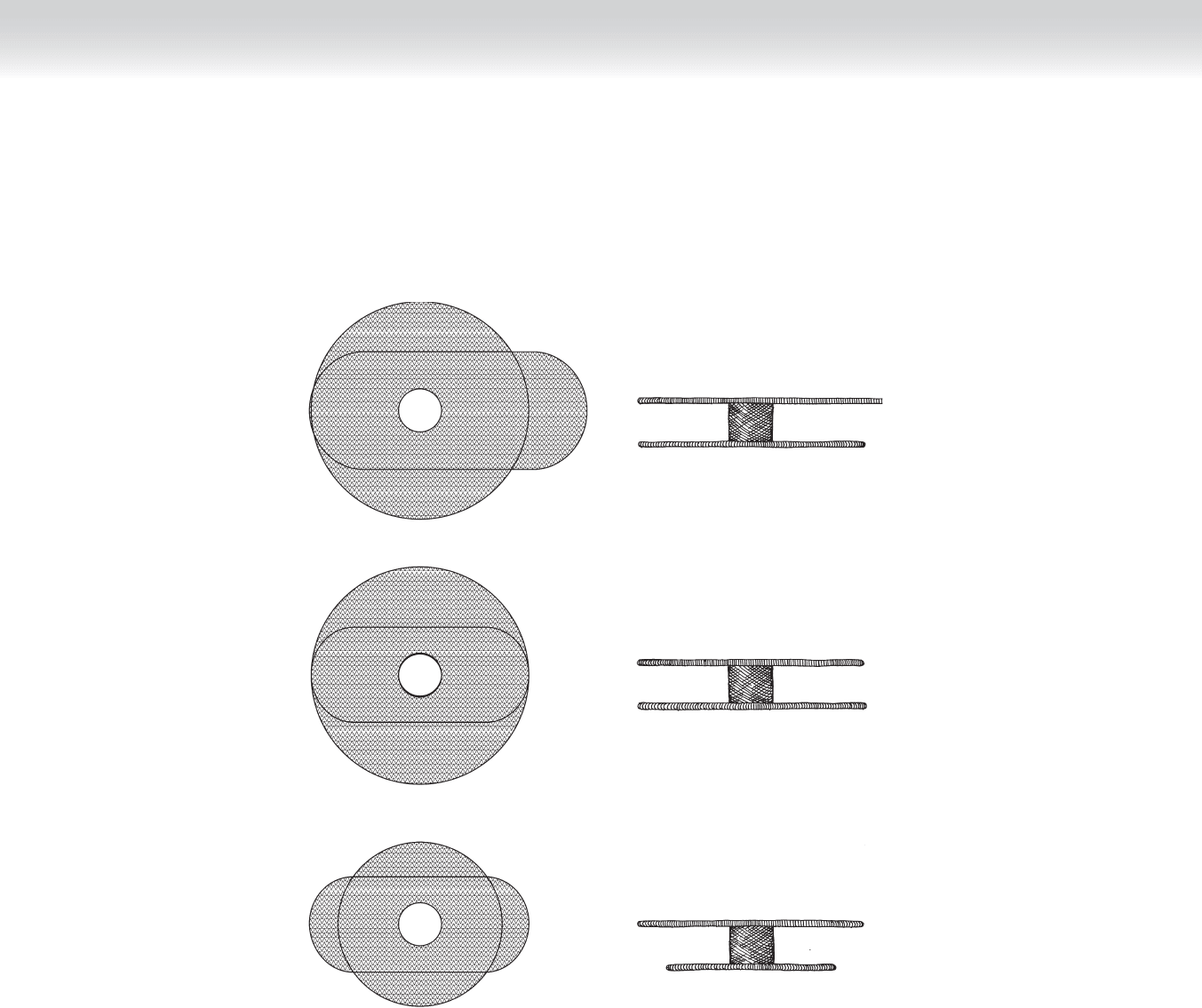
CHAPTER 72 • Mesh Repair 795
Extended
Large
Medium
Anterior flap
Posterior flap
Anterior flap
Posterior flap
Anterior flap
Posterior flap
FIGURE 72 –1

796 Section XI • Hernias
◆ The PHS mesh is loaded onto an empty sponge forceps as illustrated in Figure 72-2 and
inserted through the internal ring. When the extended size is being used, the shorter of
the two long anterior fl aps should be positioned medially.
◆ The direction of insertion should be toward the umbilicus. The index fi nger of the opposing
hand can be inserted through the ring into the preperitoneal space as a guide.
◆ The posterior fl ap of the mesh should be spread out in the preperitoneal space. This can
be done with a fi nger or a pair of forceps, depending on the size of the internal ring.
Medially and superiorly, the mesh should lie fl at underneath the pubic tubercle and
transversalis fascia. Inferiorly and laterally, the mesh will conform to the pelvic architec-
ture and external iliac vessels.
◆ The anterior fl ap is then deployed in the fl oor of the inguinal canal. It is tacked into
place in at least three locations with 2-0 Vicryl. Site A on Figure 72-3 should be over the
pubic tubercle with mesh overlap of at least 3 cm. Site B on Figure 72-3 should be a
superfi cial site fi xing the mesh to the fascia of the internal oblique only. Finally, as shown
in Figure 72-3, a notch should be cut in the inferior part of the anterior mesh at the
internal ring. The two fl aps created should be wrapped around the spermatic cord at the
internal ring and secured to each other and the shelving edge of the inguinal ligament
with 2-0 Vicryl. The resulting opening through which the spermatic cord passes should
be loose enough to allow easy introduction of a pair of forceps.
◆ The lateral fl ap is tucked under the uncut portion of the external oblique aponeurosis.
Excess mesh on the anterior fl ap can be trimmed as desired.
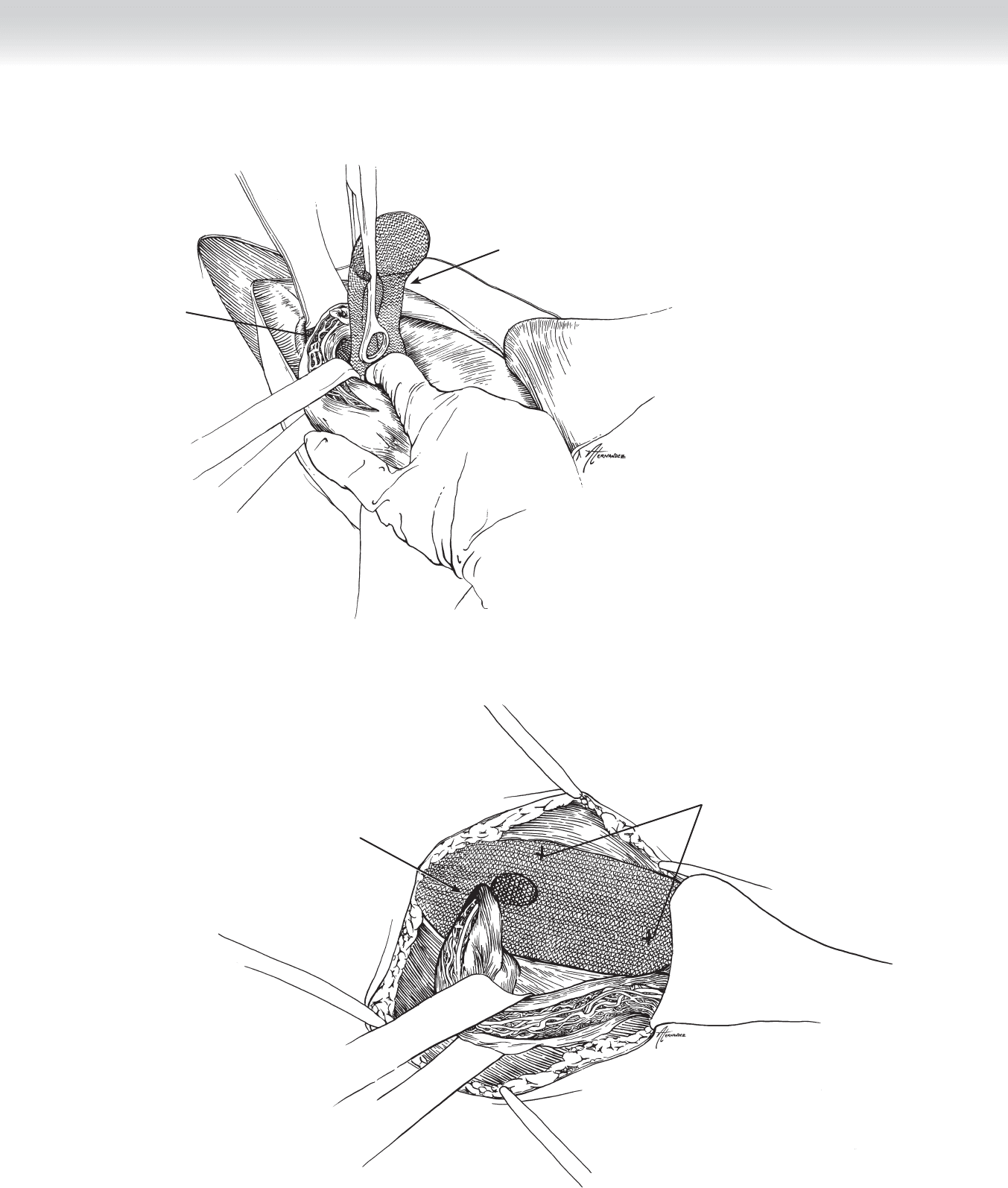
CHAPTER 72 • Mesh Repair 797
Extended size mesh
Internal ring
Superior
Lateral Medial
Inferior
FIGURE 72 –2
FIGURE 72 –3
2-0 Vicryl tacking suture
Notch located in lateral-
inferior portion of mesh
Lateral
Medial
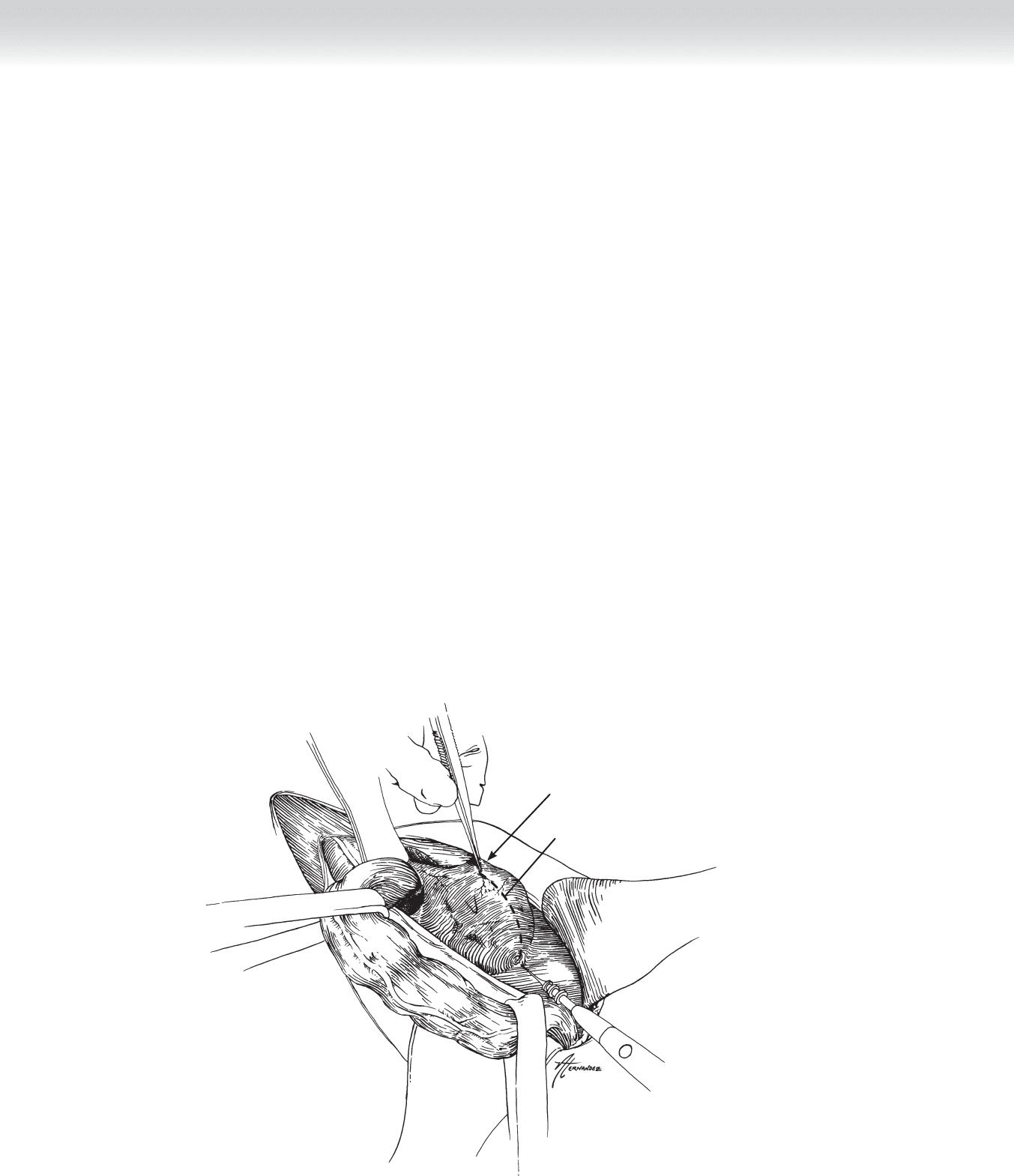
798 Section XI • Hernias
◆ Mesh repair of a direct hernia
◆ In the PHS mesh repair of a direct hernia, the posterior fl ap of the mesh is deployed into
the preperitoneal space through an incision in the attenuated transversalis fascia. If the
hernia is a large direct hernia, you may desire to resect some of the attenuated transversa-
lis fascia as shown in Figure 72-4.
◆ As has always been the case, the spermatic cord should be inspected and explored to
ensure there is not an indirect hernia also. The posterior fl ap of the mesh is deployed in
the preperitoneal space as shown in Figure 72-5. Care must be taken to ensure that the
mesh extends laterally to cover and protect for herniation through the internal ring. This
is sometimes facilitated by dividing and ligating the inferior epigastric vessels.
◆ In larger direct hernias, it is possible for the mesh to be extruded through the transversa-
lis fascia before fi broblastic ingrowth and collagen deposition in the mesh interstices
occurs. As a result, it is my practice to do the following: The connecting ring between the
anterior and posterior fl aps is left seated in the incision through the transversalis fascia
after the posterior fl ap is deployed. The two sides of the cut portions of the transversalis
fascia are affi xed to each other and to the medial and lateral edges of the connecting ring,
as shown in Figure 72-6. Should the incision through the transversalis be larger than the
diameter of the connecting ring, additional sutures of 2-0 Vicryl are used to approximate
the cut edges of the transversalis, again catching the underlying posterior mesh with each
suture.
Direct hernia
Incision line for transversalis fascia
FIGURE 72 –4
